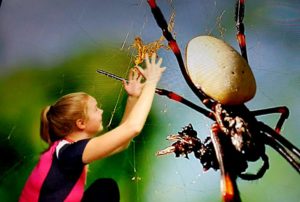Welcome to Unit 2 Experiencing STEAM: What if we could change size?
On the next two pages we will review some key resources from the Experiencing STEAM group on the theme of bees and butterflies, which we hope will give you inspiration to plan a relevant lesson with your own learners. The first case study is based on bees and the second on butterflies.
After you have reviewed these materials click on Mark Complete at the bottom of this page to continue.
Case study and lesson plan
Idea to Explore
What would happen if insects were the same size as humans or got ten times bigger than humans?
Introductory video
Methodology
The sections below – Discover, Define, Develop and Deliver – align to the Design Thinking model:

Discover
Trigger
As a trigger, we looked at and talked about the life of spiders, bees, butterflies and other insects. Ants carrying a load twice their size was used as an example of the strength of insects. We also looked at bees and asked questions like: What is the behaviour of a worker bee through its life cycle from cleaning the nest, to guarding the nest, to collecting nectar? What are the differences in the life cycle and behaviour between drones and the queen?
Variations
The whole class can examine a single species of insects or they can be divided into groups who each study a different kind of insects such as earthworms, spiders, bees, butterflies or water striders.
The class can look at killer bees as an example of science gone wrong.
Define
In the defining phase, pupils researched the habitat and transformation of the bees and studied the physiology of the bees. Afterwards, they were asked to measure and scale up the insects and draw them in 2D or build them in 3D.
Variation
Maps showing the local area could be a way to learn about scaling

Size matters, Klarup Skole, Denmark – DLaB Project Day 1
Develop
In the developing phase, the students found or took pictures of habitats. Subsequently, they created a big version of bees and their habitats in 3D or in 2D.
The next step was for the students to develop a storyboard for a short movie on how they thought our lives would be different if insects were bigger (e.g humans against giant bees).
The storyboards were then exchanged with the partner school by uploading them to a common platform (Twinspace on eTwinning).
Deliver
The final step was shooting and editing the movie based on the storyboards created by the other country. For this purpose, we used green screening to include the habitats the students had drawn/built.
Finally, the short films were shared with the partner schools by uploading them to eTwinning.


International Collaboration
We used a Padlet for brainstorming ideas.
We used eTwinning, Skype, Padlet and Tweetbeam to show and tell each other about the process and to share working methods. Tweetbeam was particularly successful in showing tweets of what was happening in the different classrooms during our international project days. Furthermore, this helped the students build relationships and develop a feeling of responsibility and ownership of their learning.
eTwinning was also used to exchange the storyboards and the final movies.
Resources Needed
- Camera with a macro lens
- Video recording tools (e.g. tablets, phones)
- Green screen or mid-green material or backing paper, plus the app Greenscreen by DoInk
- Video editing tools (e.g. iMovie, Moviemaker)
- Rulers for scaling the insects
- Calculator for scaling the insects
- Materials for creating the insects in 3D or drawing them in 2D in the corresponding scale
- Materials for creating the habitats in 3D or drawing it in 2D
STEM to STEAM Analysis
Science: Physiology of insects, the life cycle and behaviour of bees (e.g. egg, larvae, cocoon, insect), the habitat of the bees
Technology: ICT, cameras (macro photography), stop-motion movie (green screen), Skype, Padlet
Engineering: Building the habitat, scaling up bees, deciding on a suitable material
Art: Creating the big model, stop-motion movie, macro pictures
Mathematics: Scaling in 2D and 3D
Padlet – Ideas
Below is a Padlet of examples to help you to think about how you could develop the bees and butterflies theme in your own teaching context.
You can open the Padlet in a new tab if you prefer: https://padlet.com/dlaberasmus/Unit2ExperiencingSTEAMWhatifwecouldchangesize
After you have reviewed these materials click on Mark Complete at the bottom of this page to continue.
